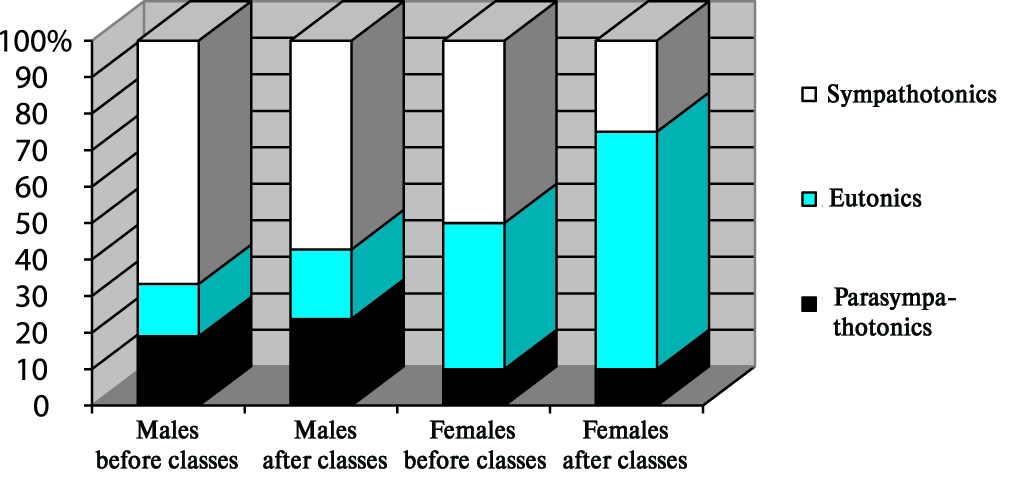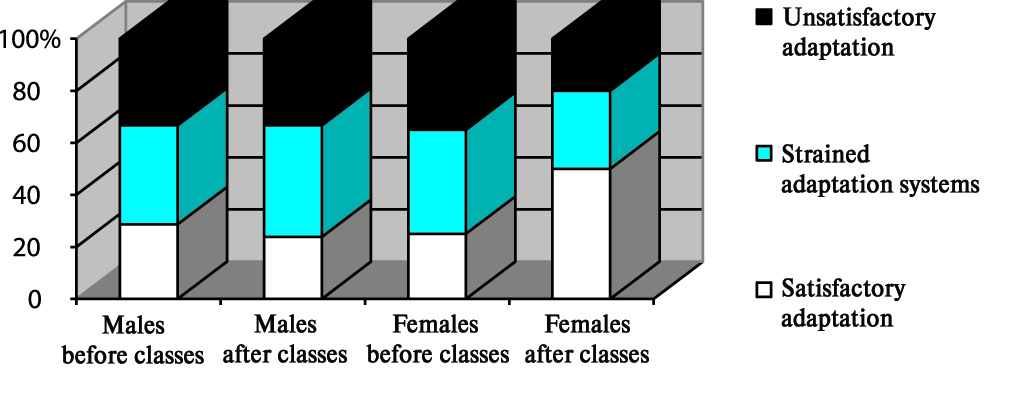Effects of academic billiards course on special health group students
Фотографии:
ˑ:
Professor, PhD V.A. Vishnevskiy
Surgut State University, Surgut
Keywords: special health group students, billiards, effects on body.
Introduction. Today, billiards is played by different population groups including persons with health impairments. At the same time establishment of billiards as an unconventional adaptive sport is contradictory. This is due not only to the high cost of initial training in billiards, but also to the effects of this training on the body that have not been studied well enough. On the one hand, billiards is recommended as an excellent means of training the extraocular muscles and visual estimation, it is seen as a kind of aerobic exercise, it is said to form correct posture, it is stressed that this sport contributes to psycho-physiological self-regulation mechanisms improvement, it is even considered as a way of intellectual development. However, all of these positive effects of billiards are mainly discussed as assumptions. Statistically supported conclusions on this subject are very scarce [2-5]. As mentioned by V.N. Baranov and B.N. Shustin in their analysis, one PhD thesis on billiards was defended in the Soviet Union and modern Russia in the period of 1939-2012 [1]. Thus, there is an obvious contradiction between the desire to develop billiards as a kind of adaptive sports and clearly insufficient scientific justification of evidence as well as organizational and methodological conditions of its use.
Objective of the research was to assess the impact of an academic billiards course on the condition of the special health group students.
Research methods and structure. The first stage of the research involved special health group students. They were examined before, during and after the academic course of physical education in the form of billiards at the initial training stage. Well-being, activity level and mood were assessed before and after the classes, a rhythmogram of the heart was recorded while at rest and in the orthostatic test, such psycho-physiological parameters as the level of psycho-emotional stress, functional asymmetry of the cerebral hemispheres, the speed of the motor reaction, response to a moving object (RMO) and refocusing were measured, optimal vision zone was determined. Blood pressure and pulse were measured during the class, a test “10 billiard balls from the standard position” was conducted. Statistical hypotheses were verified using the Student’s t-test.
Results and discussion. Billiards classes did not cause global changes of physiological functions’ average indicators. Total power spectrum of heart rate, level of activity of very low frequency waves (VLF) and stress index were the only ones that changed significantly (Table 1). The increase of the power spectrum of heart rate most reliably characterizes the overall level of neurohumoral regulation. With regard to very low frequency waves (VLF) dynamics, it characterizes the activity of suprasegmental central ergotropic and humoral-metabolic mechanisms of heart rate regulation that are closely related to the functional state of the cerebral cortex. The increase of this indicator can probably be explained by the fact that the initial steps of learning to play billiards include mastering a number of technical elements that require concentration, static positions and multiple repetitions of standard movements. Stress index reduction indicates a decrease in psycho-emotional stress of those involved.
Table 1. Effects of academic billiards course on the state of the autonomic nervous system and the level of neurohumoral regulation of special health group students, M±σ
|
Indicators
|
Males (n = 21) |
Females (n = 20) |
||
|
before classes |
after classes |
before classes |
after classes |
|
|
Overall level of neurohumoral regulation |
||||
|
SDNN (ms)
TP (ms²) |
0.04419±0.02856 3515.8±3219.2 |
0.05342±0.02596 6661.1±5728.9* |
0.04890±0.01370 2833.0±1120.3 |
0.05355±0.01634 4714.1±3874.7* |
|
Autonomic balance |
||||
|
LF \ HF (с.u.) |
2.98±1.97 |
3.87±2.78 |
3.23±2.52 |
3.49±2.37 |
|
Status of the sympathetic part of the autonomic nervous system |
||||
|
Amo (%) |
50.23±22.54 |
45.38±16.50 |
43.30±12.61 |
40.00±12.20 |
|
LF (%) |
69.09±13.95 |
74.80±12.67 |
69.80±13.51 |
71.55±13.20 |
|
Status of the parasympathetic part of the autonomic nervous system |
||||
|
rMSSD (ms)
Variation range (ms) |
0.03680±0.02630 0.21542±0.14654 |
0.03709±0.01236 0.24052±0.10098 |
0.04395±0.01274 0.22185±0.04951 |
0.04535±0.01280 0.25130±0.08150 |
|
Energy and metabolic levels |
||||
|
VLF (ms²) |
1694.5±1500.0 |
4190.4±3565.9* |
1675.3±1560.4 |
3081.2±2534.8* |
|
Stress index (c.u.) |
260.9±209.6 |
150.3±125.4* |
134.8±73.4 |
95.0±40.9* |
* – results are significant when p < 0.05.
Analysis of the results taking into account the initial autonomic tone indicates beneficial effects of billiards on the autonomic tone of the students’ bodies: a decrease in the number of sympathotonics (persons prone to active change of adaptive psychophysiological programs, tachycardia, etc) is observed, and the number of persons with balanced sympathetic and parasympathetic influences increases. These changes are especially pronounced in female students (Figure 1).

Figure 1. Effects of the academic billiards course on the initial autonomic tone of special health group students
A significant share in the sample (especially among male students) constitutes of persons who in the initial state have the regulation with an increased influence of the sympathetic part and strained regulation systems due to inconsistent influences of the sympathetic and parasympathetic parts of the autonomic nervous system. As a result of the course, the share of students with normal regulation systems increased. One can talk about satisfactory adaptation only with regards to a relatively large share of female students (Figure 2). Physiological indicators remain fairly stable during the course too.

Figure 2. Adaptive capabilities dynamics of special health group students during academic billiards course
The dynamics of a number of psychophysiological indicators is presented in Table 2. Its analysis shows that for the male students the academic billiards course significantly reduces the activity of the left and right hemispheres of the brain, and as a result – the overall activity of the cerebral hemispheres which characterizes the level of psychoemotional stress. At the same time refocusing ability improves and a tendency of a delay in the “Response to a moving object” test emerges. For the female students the course also contributed to a reduction in the activity of the cerebral hemispheres, but at the same time a speed increase of the motor reaction to a light stimulus was detected.
Table 2. Psychophysiological indicators dynamics during academic billiards course, M±σ
|
Indicators
|
Males (n = 21) |
Females (n = 20) |
||
|
before classes |
after classes |
before classes |
after classes |
|
|
Psychophysiological indicators |
||||
|
Refocusing (s) |
65.0±31.0
|
46.7±25.3*
|
47.7±14.7
|
45.9±14.6
|
|
Accuracy in RMO test (c.u.) |
28.3±15.5 |
33.2±13.7
|
35.3±12.0
|
31.6±9.4
|
|
Variation range in RMO test (c.u.) |
69.5±38.6 |
61.9±27.8
|
93.0±42.0
|
80.0±53.9
|
|
Tendency of a delay (c.u.) |
18.7±12.8
|
30.1±15.0*
|
33.2±12.6
|
29.9±12.0
|
|
Tendency of a preaction (c.u.) |
36.5±16.9
|
35.4±19.2
|
42.0±18.8
|
33.4±17.5
|
|
Motor reaction time (left arm, ms) |
243.3± 43.8
|
227.6± 62.0 |
288.3± 121.1
|
220.4± 48.3*
|
|
Motor reaction time (right arm, ms) |
249.7± 36.2
|
250.6± 67.3
|
318.4± 178.2
|
230.2± 43.6*
|
|
Activity of the left hemisphere (c.u.) |
86.6±44.7
|
58.7±28.2*
|
80.2±36.9
|
51.1±20.5*
|
|
Activity of the right hemisphere (c.u.) |
83.7±52.4
|
57.4±27.4*
|
73.0±38.5
|
48.7±24.1*
|
|
Psychoemotional stress level (c.u.) |
170.3± 93.6
|
115.6± 53.6*
|
153.2± 74.3
|
96.8± 45.2*
|
* – results are significant when p < 0.05.
Subjective state assessment was also different for male and female students (Table 3). Overall well-being improvement was observed in female students, while male students reported increased activity and improved mood. This may be due to the fact that the male students were more active in their desire to master the basic techniques of billiards. With regard to the visual analyzer, judging by the optimal vision zone, no statistically significant changes were observed, although there is some tendency of fatigue (Table 3). Results of the control test conducted at the end of the class are better with the male students (Table 3).
Table 3. Subjective assessment by those involved of their condition, optimal vision zone and results of the control test during academic billiards course, M±σ
|
Indicators
|
Males (n = 21) |
Females (n = 20) |
||
|
before classes |
after classes |
before classes |
after classes |
|
|
Subjective state assessment |
||||
|
Well-being (point) |
6.5±1.2 |
6.6±1.1 |
5.8±1.0 |
6.7±1.1* |
|
Activity level (point) |
5.7±1.4 |
6.7±1.4* |
5.5±1.1 |
5.7±1.7 |
|
Mood (point) |
6.5±1.2 |
7.3±1.1* |
6.5±1.3 |
6.7±1.6 |
|
Visual analyzer condition |
||||
|
Optimal vision zone (cm) |
226±135
|
188±131
|
297±132
|
278±123
|
|
Control test |
||||
|
Control test of billiard balls |
|
8.05±1.93
|
|
6.85±2.58
|
* – results are significant when p < 0.05.
Conclusion. The academic billiards course helps to increase the general level of neurohumoral regulation; step up the energy-metabolic level of the heart rate control; increase the share of students with balanced sympathetic and parasympathetic influences and normal regulation systems; decrease the activity rates of the left and right hemispheres and the total cerebral activity rate; and decrease the general mental/ emotional stress level. The male students also reported improvements in the activity and mood; and the proportion of the female students with the satisfactory adaptation and improved well-being was found to increase.
References
- Baranov V.N. Razvitie dissertatsionnykh issledovaniy po problemam tematiki sporta vysshikh dostizheniy i podgotovki sportivnogo rezerva [Development of dissertation research on the issues of elite sport and training of sports reserve]. Vestnik sportivnoy nauki, 2013, no. 5, pp. 7-15.
- Zakhar'eva N.N., Barchukova G.V. Vliyanie predstartovykh sostoyaniy na sportivnuyu rezultativnost bilyardistov [The Influence of Prestarting Conditions on Sports Performance of Billiard Players]. Teoriya i praktika fiz. kultury, 2013, no. 12, pp. 72-74.
- Abernethy B., Neal R.J., Koning P. Visual-perceptual and cognitive differences between expert, intermediate, and novice snooker players. Applied Cognitive Psychology, 1994, vol. 8, no. 3, pp. 185-211.
- Adams R.M. Momentum in the performance of professional pocket billiards players. International Journal of Sports Psychology, 1995, no. 26, pp. 580-587.
- Memmert D., Simons D.J., Grimme T. The relationship between visual attention and expertise in sports. Psychology of Sport and Exercise, 2009, vol. 10, no. 1, pp. 146-151.
Corresponding author: apokin_vv@mail.ru
Abstract
Subject to the study were the special health group students engaged in academic billiards course; and the study data and analyses found the course being beneficial as it helped: increase the general levels of neurohumoral regulation; step up the energy-metabolic level of heart rate control; increase the share of students with balanced sympathetic and parasympathetic influences and normal regulation systems; decrease the activity rates of the left and right hemispheres and the total cerebral activity rate; and decrease the general mental/ emotional stress level. The male students also reported improvements in the activity and mood; and the proportion of the female students with the satisfactory adaptation and improved well-being was found to increase.



